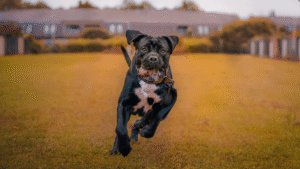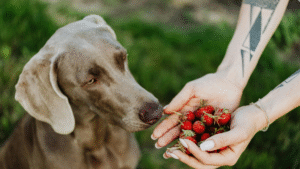Have you ever seen your dog grab something off the floor? Or tug at your favorite shoe with their mouth? If you have, then you already know why the commands “leave it” and “drop it” are so important.
In this guide, we’ll show you exactly how to teach your dog these two lifesaving commands. Whether you’re worried about your dog’s safety, your belongings, or simply want to build better communication, these commands will work wonders.

Why “Leave It” and “Drop It” Are Important
Dogs are naturally curious and tend to explore the world with their mouths. While this can be cute when it involves toys or slippers, it can become dangerous if they pick up something harmful—like a chicken bone, a sock, or toxic food. Sharp objects, poisonous substances, and everyday household items can all pose risks if your dog isn’t properly trained.
Leave It
“Leave it” is your first line of defense against most of these dangers. When you train your dog to leave something alone, they’ll learn to ignore tempting objects before they even touch them.
Drop It
“Drop it” is useful for items your dog already has in their mouth. Toys, shoes, socks, or even food should come right out when you give the command.
Training your dog to drop objects is especially important for more excitable or possessive dogs. You never know when you might need to get something away from them quickly—especially in an emergency.
Impulse control and basic obedience are essential parts of any dog training program, and “leave it” and “drop it” are excellent places to start. These commands are useful for every dog and help prevent many common (and dangerous) problems before they start.
Leave It vs. Drop It: What’s the Difference?
The difference between “leave it” and “drop it” is simple:
-
“Leave it” means your dog should ignore something they haven’t touched yet.
-
“Drop it” means they should let go of something they already have in their mouth.
The challenge is helping your dog understand the distinction and respond consistently to both cues.
Leave It
-
Triggered before your dog picks something up or touches it.
-
Means, “Don’t touch or pay attention to that thing.”
Example: You see your dog staring at a chicken bone on the sidewalk. You say, “Leave it,” and the moment they look away, you reward them with a treat.
Drop It
-
Triggered after your dog already has something in their mouth.
-
Means, “Release that thing right now.”
Example: Your dog has a sock in their mouth. You say, “Drop it,” and when they release it, you reward them with a treat.

Basic Dog Training Tips for Success
Before you start training, set your dog up for success. A few simple principles can make a big difference.
Keep It Short
Your dog learns through repetition, but their attention span is short. Opt for brief, frequent training sessions—about 5–10 minutes at a time.
Use High-Value Treats
Choose treats your dog finds irresistible—small, flavorful pieces like chicken, cheese, or soft training treats work best.
Practice at Home
Start in a quiet, distraction-free area. Once your dog understands the command, gradually introduce distractions and new environments.
Be Patient
Training is a learning process for both you and your dog. Keep sessions positive and enjoyable. Punishment can create fear and slow progress—focus instead on rewarding the right behavior.
Teaching Your Dog to “Leave It” Step-by-Step
The “leave it” command teaches your dog that ignoring temptation pays off. The idea is to make your dog realize that not going for something leads to better rewards.
Step 1: Show and Say
-
Hold a treat in each hand.
-
Show your dog one closed hand with a treat inside.
-
Say, “Leave it.”
-
When your dog stops sniffing or looking at your hand, immediately reward them with the treat from your other hand.
Step 2: Change It Up
-
Place a treat on the floor and cover it with your hand.
-
Give the “leave it” command.
-
Reward with a treat from your other hand as soon as your dog backs away.
-
Gradually re
Dogs need to apply commands outside of training sessions. Practice “leave it
-
duce how much you cover the treat until your dog can ignore it even when it’s fully visible.
Step 3: Get Moving
-
Drop a treat or toy on the floor and say, “Leave it.”
-
Reward immediately if your dog pauses or looks at you instead of lunging.
-
Repeat with moving objects or higher temptations as your dog improves.

Teach “Leave It” in Real-Life Situations
” in different environments and with real-world items: food scraps, socks, toys, or shoes. You can even turn it into a fun game by hiding treats and using “leave it” as part of a treasure hunt.
Teaching Your Dog to “Drop It” Step-by-Step
The “drop it” command helps your dog understand that giving something up leads to something better. You’re teaching them that cooperation is more rewarding than possession.
Step 1: The Toy Trick
-
Offer your dog a toy they like but aren’t obsessed with.
-
Once they take it, say, “Drop it,” while showing a high-value treat.
-
When they release the toy, reward immediately.
-
Repeat several times.
Step 2: Add Incentive
As your dog improves, use “drop it” during play sessions. Toss a toy, let your dog fetch it, and use the cue when they return. Reward every successful drop, even if you have to trade several times.
Step 3: Switch to Real Objects
Start with low-value items (like towels or leashes), then move to more tempting ones (like food or favorite toys).
If your dog resists, offer a better reward next time. Never pull something from their mouth—this can create defensiveness or aggression.

Common Dog Training Mistakes to Avoid
Even experienced dog owners can make mistakes when teaching these commands. Avoid these common pitfalls:
Mixing Up the Commands
Use the correct cue for the right situation—“leave it” before your dog touches something, and “drop it” once they have it.
Overusing the Command
Repeating “leave it” or “drop it” multiple times teaches your dog to wait until you’ve said it repeatedly before responding. Say it once, then wait for compliance.
Forcing the Issue
Never yank something out of your dog’s mouth. It can damage trust and lead to resource guarding. Always use positive reinforcement and trade-offs.
Ignoring Real-Life Practice
Training at home is a start, but your dog must learn to generalize commands. Practice “leave it” and “drop it” in different settings and with various distractions.
Help! My Dog Isn’t Listening!
Not every dog will pick up these commands immediately—and that’s okay. Try these quick fixes if your dog struggles:
Go Back to Basics
If your dog struggles with advanced steps, return to an easier version and rebuild confidence.
Use Better Rewards
If kibble isn’t cutting it, switch to higher-value treats like chicken or cheese.
Reduce Distractions
Work in a quiet space until your dog is more focused, then slowly increase the challenge.
Time Your Rewards
Reward at the exact moment your dog performs the correct behavior—timing is everything.
Real-Life Applications for “Leave It” and “Drop It”
These commands come in handy in countless everyday scenarios:
-
Outside: Keep your dog from picking up trash, discarded food, or harmful items on walks.
-
Indoors: Stop your dog from chewing socks, toys, or furniture.
-
Play Sessions: Maintain control during games like fetch by using “drop it.”
-
Emergencies: Prevent your dog from swallowing dangerous items such as bones, medication, or spoiled food.
You can also practice with objects that trigger guarding instincts—like favorite toys—to reinforce calm behavior under pressure.
Strengthening the Commands Long-Term
Consistency is the key to lasting success. Keep practicing even after your dog masters the basics.
Practice Sessions
Reinforce both commands several times a week to keep them fresh in your dog’s mind.
Incorporate into Daily Routines
Use “leave it” and “drop it” naturally throughout the day. The more often your dog hears the commands in context, the stronger the habit becomes.
Mix Up Rewards
Occasionally reward your dog with treats, toys, or praise to maintain motivation.
You can even turn practice into games—hide treats around the house and use “leave it” to test your dog’s impulse control before they earn the reward.
Positive Reinforcement: Building Trust and Cooperation
Positive reinforcement isn’t just about treats—it’s about communication and trust. When your dog learns that following your cues leads to good outcomes, they’ll listen more willingly and with enthusiasm.
Over time, you can reduce treat frequency and rely on praise, petting, or play as rewards. The goal is for your dog to obey because they understand and trust you, not just because they expect food.
Final Thoughts
Teaching your dog to “leave it” and “drop it” is one of the best things you can do for their safety and your peace of mind. These commands protect your dog from harm, reduce stress in your household, and strengthen your bond through mutual understanding.
With patience, consistency, and positive reinforcement, you’ll have a dog that listens, thinks before acting, and makes better choices every day. It’s not just about obedience—it’s about teamwork, safety, and trust.
- Homemade Calming Spray To Help Dogs During Training - November 12, 2025
- 7 DIY Dog Training Tools You Can Make From Household Items - November 12, 2025
- How To Make Your Own Clicker For Dog Training - November 12, 2025
